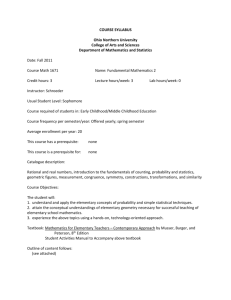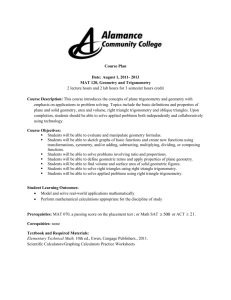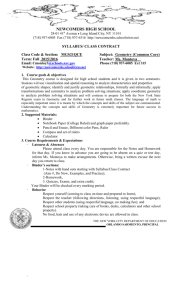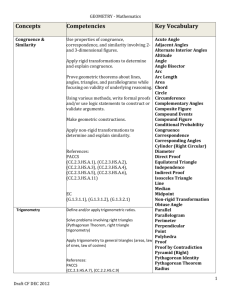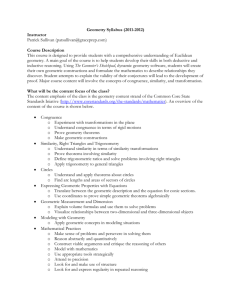Geometry Pacing Congruence, Proof, and Constructions September
advertisement
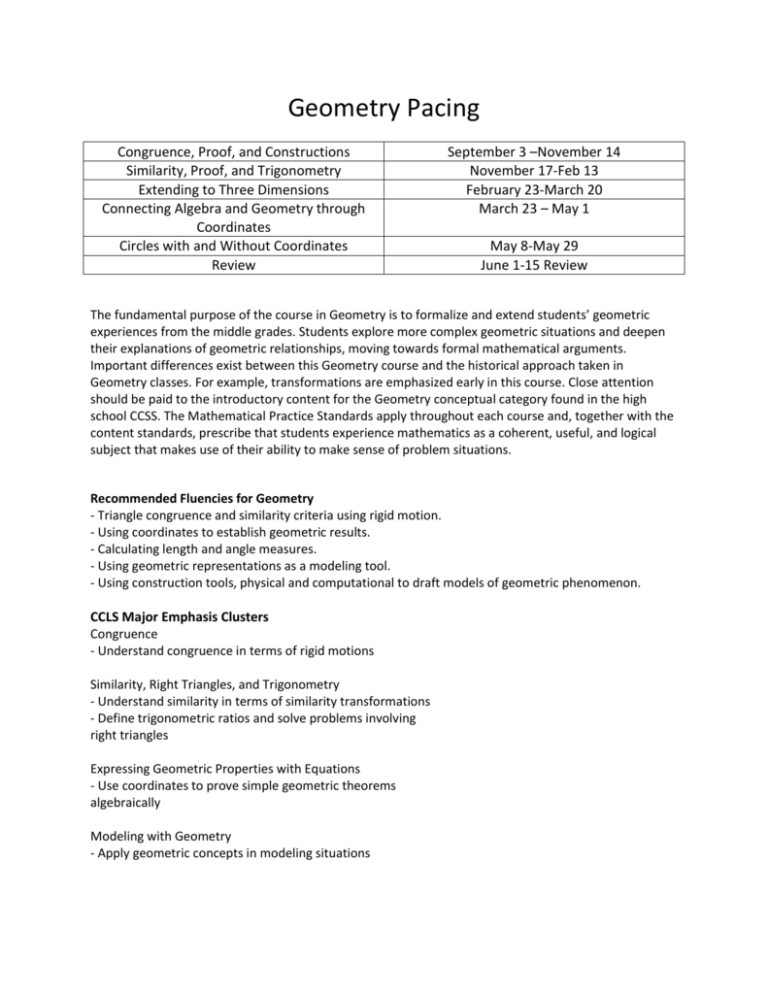
Geometry Pacing Congruence, Proof, and Constructions Similarity, Proof, and Trigonometry Extending to Three Dimensions Connecting Algebra and Geometry through Coordinates Circles with and Without Coordinates Review September 3 –November 14 November 17-Feb 13 February 23-March 20 March 23 – May 1 May 8-May 29 June 1-15 Review The fundamental purpose of the course in Geometry is to formalize and extend students’ geometric experiences from the middle grades. Students explore more complex geometric situations and deepen their explanations of geometric relationships, moving towards formal mathematical arguments. Important differences exist between this Geometry course and the historical approach taken in Geometry classes. For example, transformations are emphasized early in this course. Close attention should be paid to the introductory content for the Geometry conceptual category found in the high school CCSS. The Mathematical Practice Standards apply throughout each course and, together with the content standards, prescribe that students experience mathematics as a coherent, useful, and logical subject that makes use of their ability to make sense of problem situations. Recommended Fluencies for Geometry - Triangle congruence and similarity criteria using rigid motion. - Using coordinates to establish geometric results. - Calculating length and angle measures. - Using geometric representations as a modeling tool. - Using construction tools, physical and computational to draft models of geometric phenomenon. CCLS Major Emphasis Clusters Congruence - Understand congruence in terms of rigid motions Similarity, Right Triangles, and Trigonometry - Understand similarity in terms of similarity transformations - Define trigonometric ratios and solve problems involving right triangles Expressing Geometric Properties with Equations - Use coordinates to prove simple geometric theorems algebraically Modeling with Geometry - Apply geometric concepts in modeling situations Congruence, Proof, and Constructions This topic embodies critical changes in Geometry as outlined by the Common Core. The heart of the module is the study of transformations and the role transformations play in defining congruence. Students begin this topic with Basic Constructions. Major constructions include an equilateral triangle, an angle bisector, and a perpendicular bisector. Students synthesize their knowledge of geometric terms with the use of new tools and simultaneously practice precise use of language and efficient communication when they write the steps that accompany each construction (G.CO.A.1). Constructions segue Unknown Angles, which consists of unknown angle problems and proofs. Transformations/Rigid Motions and Congruence, builds on students’ intuitive understanding developed in Grade 8. With the help of manipulatives, students observed how reflections, translations, and rotations behave individually and in sequence (8.G.A.1, 8.G.A.2). In high school Geometry, this experience is formalized by clear definitions (G.CO.A.4) and more in-depth exploration (G.CO.A.3, G.CO.A.5). The concrete establishment of rigid motions also allows proofs of facts formerly accepted to be true (G.CO.C.9). Similarly, students’ Grade 8 concept of congruence transitions from a hands-on understanding (8.G.A.2) to a precise, formally notated understanding of congruence (G.CO.B.6). Similarity, Proof, and Trigonometry To be able to define similarity, there must be a definition of similarity transformations and consequently a definition for dilations. Students are introduced to the progression of terms beginning with scale drawings, which they first study in Grade 7 (Module 1, Topic D), but in a more observational capacity than in Grade 10: Students determine the scale factor between a figure and a scale drawing or predict the lengths of a scale drawing, provided a figure and a scale factor. Students begin with a review of scale drawings followed by systematically creating scale drawings. The study of scale drawings, specifically the way they are constructed under the ratio and parallel methods, gives us the language to examine dilations. The comparison of why both construction methods (MP.7) result in the same image leads to two theorems: the triangle side splitter theorem and the dilation theorem. Students learn what a similarity transformation is. After discussing similarity in general, the scope narrows, and students study criteria for determining when two triangles are similar (G-SRT.A.3). Part of studying triangle similarity criteria (Lessons 15 and 17) includes understanding side length ratios for similar triangles, which begins to establish the foundation for trigonometry (G-SRT.B.5). Students will be laying the foundation to studying trigonometry by focusing on similarity between right triangles. Students discover that a right triangle can be divided into two similar sub-triangles (MP.2) to prove the Pythagorean theorem (G-SRT.B.4). An introduction to trigonometry, specifically right triangle trigonometry and the values of side length ratios within right triangles, is provided by defining the sine, cosine, and tangent ratios and using them to find missing side lengths of a right triangle (G-SRT.B.6). Students are introduced to the functions arcsin,arccos, and arctan, which are formally taught as inverse function. Extending to Three Dimensions This topic begins with studies of informal limit arguments to find the area of a rectangle with an irrational side length and of a disk (G-GMD.A.1). It also focuses on properties of area that arise from unions, intersections, and scaling. These topics prepare for understanding limit arguments for volumes of solids. Cross-sections of solids are studied and are classified as similar or congruent (G-GMD.B.4). Students will use formulas for cones, cylinders, prisms and spheres to solve real world problems. Connecting Algebra and Geometry through Coordinates Students explore and experience the utility of analyzing algebra and geometry challenges through the framework of coordinates. To set the stage for complex work in analytic geometry (computing coordinates of points of intersection of lines and line segments or the coordinates of points that divide given segments in specific length ratios, and so on), students will describe the region via systems of algebraic inequalities (A-REI.D.12). To fully develop the analysis of perimeter and area of a polygon in terms of the coordinates of its vertices (G-GPE.B.7), students will derive the area 𝐴 of a triangle with coordinates. Circles with and Without Coordinates With geometric intuition well established previously, students are now ready to explore the rich geometry of circles. This module brings together the ideas of similarity and congruence. Students use coordinate geometry to establish the equation of a circle. This course will not conclude with a NYS Regents Exam in Geometry
